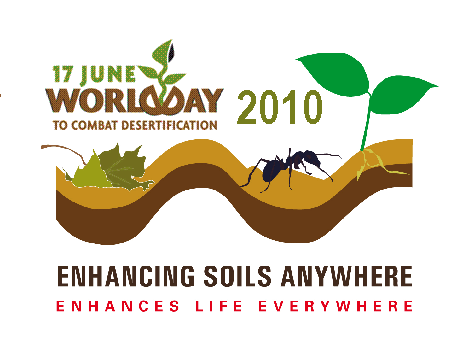World Day To Combat Desertification and Drought 2024 is on Monday, June 17, 2024: List of World days.Someone?
Monday, June 17, 2024 is World Day To Combat Desertification and Drought 2024. The World Day to Combat Desertification and Drought is a United Nations observance each June 17. Its purpose is to highlight ways to prevent desertification and recover from drought.

The World Day to Combat Desertification and Drought is a United Nations observance each June 17. Its purpose is to highlight ways to prevent desertification and recover from drought.

January 1 New Year's Day (New Year's Day)
February 2 World Wetlands Day (World Wetlands Day)
February 14 Valentine's Day (Valentine's Day)
March 3 on the ears of the love
March 5 young volunteers on service
March 8 International Women's Day (International Women 'Day)
March 9, Mother River Protection
March 12 Arbor Day in China (China Arbor Day)
White Day on March 14 (White Day)
March 14, the International Police (International Policemen 'Day)
March 15, the interests of consumers the world (World Consumer Right Day)
March 21, the world's forests (World Forest Day)
March 21 World Sleep Day (World Sleep Day)
March 22 World Water Day (World Water Day)
March 23 World Meteorological Day (World Meteorological Day)
March 24 of the World TB Day (World Tuberculosis Day)
April 1 April Fool's Day (April Fools' Day)
April 5 Ching Ming Festival (Tomb-sweeping Day)
April 7 World Health Day (World Health Day)
April 22 World Earth Day (World Earth Day)
April 26 World Intellectual Property Day (World Intellectual Property Day)
May 1 International Labor Day (International Labour Day)
May 3 World Asthma Day (World Asthma Day)
May 4th Youth Day in China (Chinese Youth Day)
May 8 World Red Cross Day (World Red-Cross Day)
May 12 international Hu Shijie (International Nurse Day)
May 15 International Day of Families (International Family Day)
May 17 World Telecommunications Day (World Telecommunications Day)
May 20, the National Student Nutrition
May 23, the international milk (International Milk Day)
May 31 World No Tobacco Day (World No-Smoking Day)
June 1 International Children's Day (International Children's Day)
June 5 World Environment Day (International Environment Day)
June 6 eye on the love
June 17 World to Combat Desertification and Drought on the (World Day to combat desertification)
June 23, the International Olympic (International Olympic Day)
June 25th National Land Day
June 26 International Anti-Drug Day (International Day Against Drug Abuse and Illicit Trafficking)
July 1, the birth of China GCD (Anniversary of the Founding of the Chinese Communist Party)
July 1, the international construction (International Architecture Day)
July 7 anniversary of the Chinese people's War of Resistance Against Japan
July 11 World Population Day (World Population Day)
August 1 Army Day Chinese People's Liberation Army (Army Day)
August 12th International Youth Day (International Youth Day)
September 8 International Literacy Day (International Anti-illiteracy Day)
September 10 China's Teacher's Day (Teacher's Day)
September 16, the Chinese brain health
September 16, the International Ozone Layer Protection (International Day for the Preservation of the Ozone Layer)
September 20 National Love Teeth Day
September 21 ceasefire on the world (World Cease-fire Day)
September 27 World Tourism Day (World Tourism Day)
People's Republic of China on October 1 National Day (National Day)
October 1 International Music Day (International Music Day)
October 1 International Day of Older Persons (International Day of Older Persons)
October 4 World Animal Day (World Animal Day)
October 5 World Teachers Day (World Teachers' Day) (UNESCO established)
October 8, the National Hypertension
October 9 World Post Day (World Post Day)
October 10 World Mental Health Day (World Mental Health Day)
October 14th World Standards Day (World Standards Day)
October 15 the International Blind Festival (International Day of the Blind)
October 15 World Rural Women's Day (World Rural Women's Day)
October 16th World Food Day (World Food Day)
October 17 on international poverty eradication (International Day for the Eradication of Poverty)
October 24 United Nations Day (United Nations Day)
October 24 World Development Information Day (World Development Information Day)
October 28, the Chinese men's health
October 29 the International Day for Biological Diversity (International Biodiversity Day)
October 31 Halloween (Halloween)
November 8 Chinese reporters Festival
November 9 publicity on fire
November 14 World Diabetes Day (World Diabetes Day)
November 17 International University Festival
November 25 International Day for the Elimination of Violence against Women (International Day For the elimination of Violence against Women)
December 1 World AIDS Day (World AIDS Day)
December 3 World Day of Disabled Persons (World Disabled Day)
December 4, the legal system propaganda
December 9, the world soccer (World Football Day)
December 25 Christmas (Christmas Day)
December 29 the International Day for Biological Diversity (International Biological Diversity Day)
January last Sunday, the International Leprosy Day
March last full week Monday on safety education in primary and secondary school students
Full moon after the spring equinox the first Easter Sunday (Easter Monday) (possible that the March 22-4 on day 25 of the day

I need 6 events that are in June.?
1. World Environment Day 05, June
2. World Blood Donation Day 14, June
3. Flag Day, U.S. June 14
4. World Day to Combat Desertification and Drought 17, June
5. World Refugee Day 20, June
6. Father's Day June 20
7. International Day against Drug Abuse & illicit Trafficking 26, June
8. Ganga Dussehra June 11, 2010
9. National Cancer Survivors Day. Observed the first Sunday in June each year.
10. World Ocean's Day June 8
If we don't combat Global Warming, will we all freeze to death?
How Global Warming May Cause the Next Ice Age...
This article was adapted from the new, updated edition of "The Last Hours of Ancient Sunlight" by Thom Hartmann from Random House/Three Rivers Press.
Published on Friday, January 30, 2004 by CommonDreams.org
While global warming is being officially ignored by the political arm of the Bush administration, and Al Gore's recent conference on the topic during one of the coldest days of recent years provided joke fodder for conservative talk show hosts, the citizens of Europe and the Pentagon are taking a new look at the greatest danger such climate change could produce for the northern hemisphere - a sudden shift into a new ice age. What they're finding is not at all comforting.
In quick summary, if enough cold, fresh water coming from the melting polar ice caps and the melting glaciers of Greenland flows into the northern Atlantic, it will shut down the Gulf Stream, which keeps Europe and northeastern North America warm. The worst-case scenario would be a full-blown return of the last ice age - in a period as short as 2 to 3 years from its onset - and the mid-case scenario would be a period like the "little ice age" of a few centuries ago that disrupted worldwide weather patterns leading to extremely harsh winters, droughts, worldwide desertification, crop failures, and wars around the world.
Here's how it works.
If you look at a globe, you'll see that the latitude of much of Europe and Scandinavia is the same as that of Alaska and permafrost-locked parts of northern Canada and central Siberia. Yet Europe has a climate more similar to that of the United States than northern Canada or Siberia. Why?
It turns out that our warmth is the result of ocean currents that bring warm surface water up from the equator into northern regions that would otherwise be so cold that even in summer they'd be covered with ice. The current of greatest concern is often referred to as "The Great Conveyor Belt," which includes what we call the Gulf Stream.
The Great Conveyor Belt, while shaped by the Coriolis effect of the Earth's rotation, is mostly driven by the greater force created by differences in water temperatures and salinity. The North Atlantic Ocean is saltier and colder than the Pacific, the result of it being so much smaller and locked into place by the Northern and Southern American Hemispheres on the west and Europe and Africa on the east.
As a result, the warm water of the Great Conveyor Belt evaporates out of the North Atlantic leaving behind saltier waters, and the cold continental winds off the northern parts of North America cool the waters. Salty, cool waters settle to the bottom of the sea, most at a point a few hundred kilometers south of the southern tip of Greenland, producing a whirlpool of falling water that's 5 to 10 miles across. While the whirlpool rarely breaks the surface, during certain times of year it does produce an indentation and current in the ocean that can tilt ships and be seen from space (and may be what we see on the maps of ancient mariners).
This falling column of cold, salt-laden water pours itself to the bottom of the Atlantic, where it forms an undersea river forty times larger than all the rivers on land combined, flowing south down to and around the southern tip of Africa, where it finally reaches the Pacific. Amazingly, the water is so deep and so dense (because of its cold and salinity) that it often doesn't surface in the Pacific for as much as a thousand years after it first sank in the North Atlantic off the coast of Greenland.
The out-flowing undersea river of cold, salty water makes the level of the Atlantic slightly lower than that of the Pacific, drawing in a strong surface current of warm, fresher water from the Pacific to replace the outflow of the undersea river. This warmer, fresher water slides up through the South Atlantic, loops around North America where it's known as the Gulf Stream, and ends up off the coast of Europe. By the time it arrives near Greenland, it's cooled off and evaporated enough water to become cold and salty and sink to the ocean floor, providing a continuous feed for that deep-sea river flowing to the Pacific.
These two flows - warm, fresher water in from the Pacific, which then grows salty and cools and sinks to form an exiting deep sea river - are known as the Great Conveyor Belt.
Amazingly, the Great Conveyor Belt is only thing between comfortable summers and a permanent ice age for Europe and the eastern coast of North America.
Much of this science was unknown as recently as twenty years ago. Then an international group of scientists went to Greenland and used newly developed drilling and sensing equipment to drill into some of the world's most ancient accessible glaciers. Their instruments were so sensitive that when they analyzed the ice core samples they brought up, they were able to look at individual years of snow. The results were shocking.
Prior to the last decades, it was thought that the periods between glaciations and warmer times in North America, Europe, and North Asia were gradual. We knew from the fossil record that the Great Ice Age period began a few million years ago, and during those years there were times where for hundreds or thousands of years North America, Europe, and Siberia were covered with thick sheets of ice year-round. In between these icy times, there were periods when the glaciers thawed, bare land was exposed, forests grew, and land animals (including early humans) moved into these northern regions.
Most scientists figured the transition time from icy to warm was gradual, lasting dozens to hundreds of years, and nobody was sure exactly what had caused it. (Variations in solar radiation were suspected, as were volcanic activity, along with early theories about the Great Conveyor Belt, which, until recently, was a poorly understood phenomenon.)
Looking at the ice cores, however, scientists were shocked to discover that the transitions from ice age-like weather to contemporary-type weather usually took only two or three years. Something was flipping the weather of the planet back and forth with a rapidity that was startling.
It turns out that the ice age versus temperate weather patterns weren't part of a smooth and linear process, like a dimmer slider for an overhead light bulb. They are part of a delicately balanced teeter-totter, which can exist in one state or the other, but transits through the middle stage almost overnight. They more resemble a light switch, which is off as you gradually and slowly lift it, until it hits a mid-point threshold or "breakover point" where suddenly the state is flipped from off to on and the light comes on.
It appears that small (less that .1 percent) variations in solar energy happen in roughly 1500-year cycles. This cycle, for example, is what brought us the "Little Ice Age" that started around the year 1400 and dramatically cooled North America and Europe (we're now in the warming phase, recovering from that). When the ice in the Arctic Ocean is frozen solid and locked up, and the glaciers on Greenland are relatively stable, this variation warms and cools the Earth in a very small way, but doesn't affect the operation of the Great Conveyor Belt that brings moderating warm water into the North Atlantic.
In millennia past, however, before the Arctic totally froze and locked up, and before some critical threshold amount of fresh water was locked up in the Greenland and other glaciers, these 1500-year variations in solar energy didn't just slightly warm up or cool down the weather for the landmasses bracketing the North Atlantic. They flipped on and off periods of total glaciation and periods of temperate weather.
And these changes came suddenly.
For early humans living in Europe 30,000 years ago - when the cave paintings in France were produced - the weather would be pretty much like it is today for well over a thousand years, giving people a chance to build culture to the point where they could produce art and reach across large territories.
And then a particularly hard winter would hit.
The spring would come late, and summer would never seem to really arrive, with the winter snows appearing as early as September. The next winter would be brutally cold, and the next spring didn't happen at all, with above-freezing temperatures only being reached for a few days during August and the snow never completely melting. After that, the summer never returned: for 1500 years the snow simply accumulated and accumulated, deeper and deeper, as the continent came to be covered with glaciers and humans either fled or died out. (Neanderthals, who dominated Europe until the end of these cycles, appear to have been better adapted to cold weather than Homo sapiens.)
What brought on this sudden "disappearance of summer" period was that the warm-water currents of the Great Conveyor Belt had shut down. Once the Gulf Stream was no longer flowing, it only took a year or three for the last of the residual heat held in the North Atlantic Ocean to dissipate into the air over Europe, and then there was no more warmth to moderate the northern latitudes. When the summer stopped in the north, the rains stopped around the equator: At the same time Europe was plunged into an Ice Age, the Middle East and Africa were ravaged by drought and wind-driven firestorms. .
If the Great Conveyor Belt, which includes the Gulf Stream, were to stop flowing today, the result would be sudden and dramatic. Winter would set in for the eastern half of North America and all of Europe and Siberia, and never go away. Within three years, those regions would become uninhabitable and nearly two billion humans would starve, freeze to death, or have to relocate. Ci


